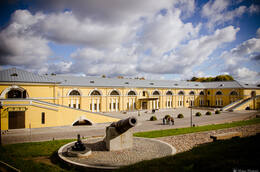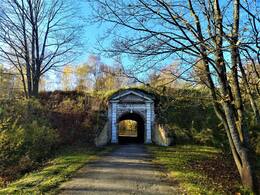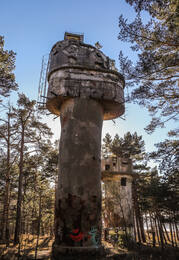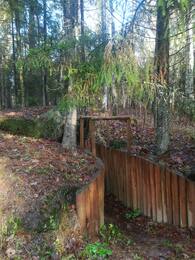Kaponieris
Caponier. (French caponnière – niche) an engineering structure in front of a defensive position, which ensures the transmission of flank fire in two opposite directions. In fortresses, a caponier allows firing along the entire length of the defensive ditch. This type of caponier has been used in fortress construction since the 17th century. The most notable example in Latvia is the Daugavpils Fortress.
In modern (20th century) land forces, an area enclosed by earthen ramparts to protect combat equipment and personnel from shrapnel carried by the shock wave of an explosion (and also from radiation in a nuclear explosion). The rampart caponier is additionally camouflaged with nets, bushes, etc.
More information sources
Caponnière. Wikipedia. https://fr.wikipedia.org/wiki/Caponni%C3%A8re#D%C3%A9finition
Captain. Википедия.
https://ej.uz/uiss h
ttps://ej.uz/gw1h
Multimedia resource “Dinaburg Fortress” (Photo gallery) http://dinaburgascietoksnis.lcb.lv/arejaisizskatsLV.php
Related timeline
Related objects
Daugavpils Fortress
Daugavpils Fortress is an architectural, cultural and historical heritage monument of national importance. It is the last bastion-type fortress built in the world and the only surviving example of a fortress from the first half of the 19th century in Central Europe, which has been preserved without significant changes.
Its construction began in 1810, as Tsarist Russia prepared for Napoleonic invasion, and continued until 1878. In 1812, Russian and French troops fought at the unfinished fortress. After the Napoleonic Wars, the construction of the fortress continued, however, already during its construction, it began to lose its military importance.
During World War I (1915–1918), the fortress served as a support and logistics base for the Russian Army. In February 1918, it was occupied by German troops, and in December – by Bolshevik forces. In January 1920, the fortress was recaptured by Polish troops, who helped the Latvian Army to liberate Latgale from the Bolsheviks. From 1920 to 1940, the 4th Zemgale Division of the Latvian Army was stationed in the fortress.
After the occupation of Latvia in 1940, Red Army units were stationed at the fortress, and during the German occupation, it became the site of the prisoner-of-war camp for Red Army POWs “Stalags-340”. After the second Soviet occupation in 1944, Soviet troops were again stationed in the fortress. Latvia regained the fortress in 1993 after the Russian Army had left.
Daugavgrīva Fortress
Daugavgrīva Fortress (entry from Birzes street) is located on the Daugavgrīva Island where Buļļupe river joins the Daugava river. The fortress was built in the 17th century to defend from enemies moving in the direction of Riga, which was an important administrative, trade and production centre. Later it became the main fortification of the Latvian Army coastal defence with several support points. This defensive fortification system is one of the most valuable objects of Latvia's military heritage. This fortress has witnessed Latvian military history. For example, during the Crimean War (1853-1856) Latvian and Estonian gunboat crews were trained here. The main objective of these units was to protect local ports and the coast from attacks by the British navy. During World War I Daugavgrīva militiamen companies were formed here. These were the first Latvian combat units, which came even before the Latvian Riflemen. Nowadays it is possible to see the territory of the fortress. ‘Komētforts’ and the Seaside Nature Park are located nearby and Mangaļsala fortifications are on the other side of the Daugava river.
Karosta, the Military port of Liepāja (tour)
The Karosta is the largest historical military territory in the Baltics and occupies almost one third of the entire territory of Liepāja. The Karosta is a unique compound of military and fortification buildings on the shores of the Baltic Sea with a special meaning in the history and architecture of Latvia and the world. The Karosta features such military heritage sites as the North Pier and forts, the Redan, Karosta Prison, Karosta Water Tower, St. Nicholas Orthodox Maritime Cathedral, Oskars Kalpaks Bridge and others.
Red Army bunker and caponiers in Aizvīķi Park
Aizvīķi Manor Park is located in Aizvīķi, Gramzda Parish, just a few kilometers from the Lithuanian border.
In Aizvīķi Park, the sites of World War II bunkers and trenches are still clearly visible. A Red Army bunker has been restored in the park.
One of the types of weapons during World War II was the Katyusha rocket launcher system. Several such rocket launcher systems were located in Aizvīķi Park, and even today these places (caponiers) are clearly visible in nature.
To better explore the cultural and historical heritage of Aizvīķi Manor Park, we recommend using the services of a guide.
Testimonies of World War II in Aizvīķi Park
Aizvīķi Manor Park is located in Aizvīķi, Gramzda Parish, just a few kilometers from the Lithuanian border.
In Aizvīķi Park, the sites of bunkers and trenches from World War II are still clearly visible. One of the types of weapons was the rocket launcher system "Katyusha". Several such rocket launcher systems were located in Aizvīķi Park, even after the end of World War II, and these sites (caponiers) are clearly visible in nature.
This unique forest park, shrouded in secrets and legends, was created in the late 19th century as the Aizvīķi Manor Park, when the manor's baron von Korf planted the nearby hilly land with a pine and spruce forest. Later, walking paths were laid out in the 40-hectare area, other species of trees were also planted, and a pheasant garden was established.
In addition to the picturesque forest landscapes, there are also wooden fairy tale and legend characters, as well as stone sculptures that tell travelers events from the history of Aizvīķi and mark the cultural and historical sites in the park. The park also has a Green Class.
To better explore the cultural and historical heritage of Aizvīķi Manor Park, we recommend using the services of a guide.








